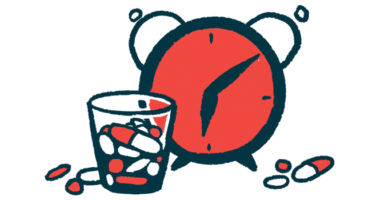Preventive Treatment with Berotralstat Lowers HAE Attack Rate, BioCryst Says

BioCryst Pharmaceuticals presented new results from a Phase 3 clinical trial showing that preventive treatment with oral berotralstat (BCX7353) significantly lowers the frequency and may also lessen the severity of swelling attacks in people with hereditary angioedema (HAE).
The findings would have been shared at the annual meeting of the American Academy of Allergy, Asthma & Immunology (AAAAI) March 13-16 in Philadelphia, but the meeting was canceled due to the ongoing COVID-19 outbreak.
“There is tremendous enthusiasm from both patients and physicians for the potential of oral, once-daily berotralstat,” and the new results “highlight the excellent outcomes patients had in our APeX-2 trial,” William Sheridan, BioCryst chief medical officer, said in a press release.
Berotralstat is an oral inhibitor of plasma kallikrein, a precursor of bradykinin, which is produced in excess in people with HAE, leading to swelling and pain. The agent is currently under review in the U.S. and Japan for approval as a once-daily capsule for the preventive treatment of HAE.
Researchers prepared a poster analyzing response to berotralstat and attack rates, “Relative Reductions in Attack Rate With Prophylactic Berotralstat (BCX7353) in Subjects with Hereditary Angioedema (HAE): Responder Analysis from the APeX-2 Study” (abstract #326).
The results covered 121 patients with HAE type 1 or type 2 who were given preventive treatment with either 150 mg of berotralstat, 110 mg of berotralstat, or a placebo, administered orally once daily for 24 weeks, as part of the APeX-2 Phase 3 trial (NCT03485911).
The 150 mg and 110 mg doses of berotralstat led to 50% or greater reduction from baseline (the study’s start) in attack rates in 57.5% and 51.2% of the patients, respectively, compared with 25% of placebo-treated patients.
Half of the participants treated with 150 mg and 26.8% of those treated with 110 mg saw their attacks decline by at least 70%, compared with 15% for those on placebo. Also, 22.5% and 9.8% of the patients on berotralstat achieved a 90% or greater reduction.
A model of the potential factors affecting patients’ response (including age, gender, prior androgen use, age, body mass index, attack rate at study start, and function of C1-inhibitor — the faulty protein in HAE types 1 and 2 — indicated that only treatment with berotralstat was a significant predictor of a clinical benefit.
An exploratory analysis of the APeX-2 study, “Patterns of Treatment and Retreatment of Acute Attacks of Hereditary Angioedema (HAE) with Standard of Care (SOC) On-Demand Medication: Results from the APeX-2 Study” (abstract #331) looked at the number of swelling attacks that required repeated treatment with standard-of-care, on-demand medications.
In the trial, Firazyr (icatibant injection) was the medication more frequently used for treating HAE attacks, but also the one that more frequently resulted in re-treatments. Some 26.9% of the attacks treated initially with Firazyr needed additional doses of the same or other medication to get resolved.
The percentage of attacks needing more than one treatment dose was lower among patients on preventive therapy with 110 mg or 150 mg of berotralstat, occurring in 11.4% and 14.5% of the attacks, respectively, compared with 24.2% of the attacks in patients under placebo and “suggesting reduced attack severity on berotralstat,” the researchers wrote.
“Patients receiving berotralstat had fewer attacks, treated fewer attacks, experienced less severe attacks and used less on-demand medication compared to placebo,” Sheridan said in a separate press release. “These data from APeX-2 provide further evidence that HAE patients are seeing significant benefits from oral, once-daily berotralstat.”






